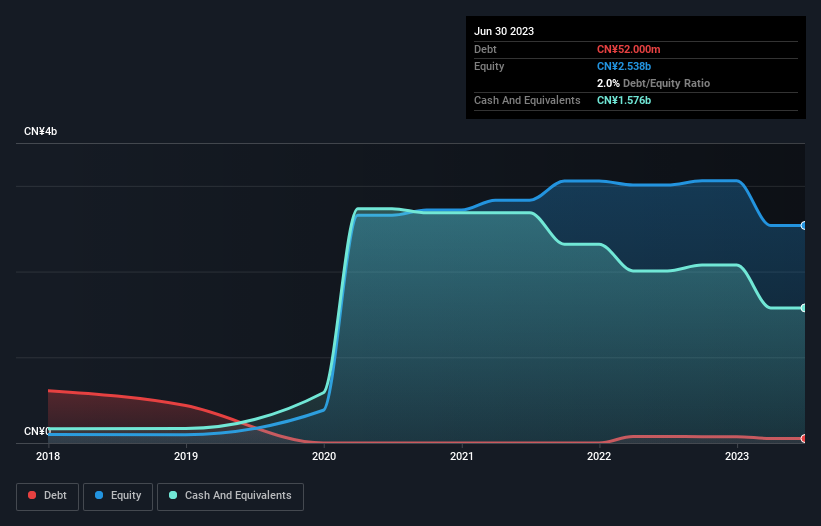
David Iben put it well when he said, 'Volatility is not a risk we care about. What we care about is avoiding the permanent loss of capital.' When we think about how risky a company is, we always like to look at its use of debt, since debt overload can lead to ruin. As with many other companies Central China New Life Limited (HKG:9983) makes use of debt. But the more important question is: how much risk is that debt creating?
When Is Debt Dangerous?
Debt and other liabilities become risky for a business when it cannot easily fulfill those obligations, either with free cash flow or by raising capital at an attractive price. Part and parcel of capitalism is the process of 'creative destruction' where failed businesses are mercilessly liquidated by their bankers. However, a more usual (but still expensive) situation is where a company must dilute shareholders at a cheap share price simply to get debt under control. By replacing dilution, though, debt can be an extremely good tool for businesses that need capital to invest in growth at high rates of return. When we think about a company's use of debt, we first look at cash and debt together.
See our latest analysis for Central China New Life
How Much Debt Does Central China New Life Carry?
The image below, which you can click on for greater detail, shows that Central China New Life had debt of CN¥52.0m at the end of June 2023, a reduction from CN¥75.7m over a year. However, its balance sheet shows it holds CN¥1.58b in cash, so it actually has CN¥1.52b net cash.

How Healthy Is Central China New Life's Balance Sheet?
The latest balance sheet data shows that Central China New Life had liabilities of CN¥2.31b due within a year, and liabilities of CN¥200.4m falling due after that. On the other hand, it had cash of CN¥1.58b and CN¥2.87b worth of receivables due within a year. So it can boast CN¥1.94b more liquid assets than total liabilities.
This surplus strongly suggests that Central China New Life has a rock-solid balance sheet (and the debt is of no concern whatsoever). With this in mind one could posit that its balance sheet means the company is able to handle some adversity. Simply put, the fact that Central China New Life has more cash than debt is arguably a good indication that it can manage its debt safely. The balance sheet is clearly the area to focus on when you are analysing debt. But ultimately the future profitability of the business will decide if Central China New Life can strengthen its balance sheet over time. So if you're focused on the future you can check out this free report showing analyst profit forecasts.
Over 12 months, Central China New Life made a loss at the EBIT level, and saw its revenue drop to CN¥2.9b, which is a fall of 18%. We would much prefer see growth.
So How Risky Is Central China New Life?
While Central China New Life lost money on an earnings before interest and tax (EBIT) level, it actually generated positive free cash flow CN¥296m. So taking that on face value, and considering the net cash situation, we don't think that the stock is too risky in the near term. The next few years will be important as the business matures. When analysing debt levels, the balance sheet is the obvious place to start. However, not all investment risk resides within the balance sheet - far from it. Be aware that Central China New Life is showing 2 warning signs in our investment analysis , and 1 of those is a bit concerning...
When all is said and done, sometimes its easier to focus on companies that don't even need debt. Readers can access a list of growth stocks with zero net debt 100% free, right now.
New: AI Stock Screener & Alerts
Our new AI Stock Screener scans the market every day to uncover opportunities.
• Dividend Powerhouses (3%+ Yield)
• Undervalued Small Caps with Insider Buying
• High growth Tech and AI Companies
Or build your own from over 50 metrics.
Have feedback on this article? Concerned about the content? Get in touch with us directly. Alternatively, email editorial-team (at) simplywallst.com.
This article by Simply Wall St is general in nature. We provide commentary based on historical data and analyst forecasts only using an unbiased methodology and our articles are not intended to be financial advice. It does not constitute a recommendation to buy or sell any stock, and does not take account of your objectives, or your financial situation. We aim to bring you long-term focused analysis driven by fundamental data. Note that our analysis may not factor in the latest price-sensitive company announcements or qualitative material. Simply Wall St has no position in any stocks mentioned.
About SEHK:9983
Central China New Life
An investment holding company, provides property management services and value-added services in the People’s Republic of China.
Adequate balance sheet low.
Market Insights
Community Narratives



